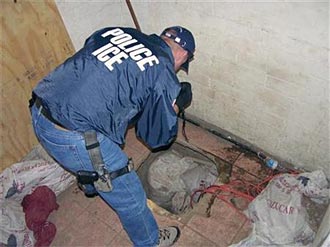
|  |  |  Americas & Beyond | July 2009 Americas & Beyond | July 2009  
Drug Cartel Tunnelers Target US Border Town
 Tim Gaynor - Reuters Tim Gaynor - Reuters
go to original
July 01, 2009


| | U.S. Immigration and Customs Enforcement police officer examines the entrance to a recently constructed tunnel at a home in Nogales, Arizona June 28, 2007. (Reuters/U.S. Immigration and Customs Enforcement) |  |
Nogales, Arizona - A resident walking near the rusted boundary fence in this Arizona border city last month reported suspicious knocking coming from an abandoned warehouse to the Border Patrol.

The agents found two men constructing the exit for a sophisticated but unfinished tunnel from Mexico. The discovery was no great surprise because authorities have been finding tunnels every two or three weeks all year.

As security tightens along the Mexico border, the twin cities of Nogales - where stores, homes and warehouses in Mexico and Arizona lie just a few yards (meters) either side of the fence - are in the grip of a tunneling boom.

The cities straddle a key drug trafficking route controlled on the south side by the powerful Sinaloa cartel, which smuggles billions of dollars worth of drugs including marijuana, cocaine and heroin to cities across the United States.

Border police have found 16 completed or partially completed tunnels here since October 1 last year - a record for the city that has a checkered history of smuggling reaching back to the era of Prohibition in the 1920s and 1930s.

"Tunnels have been around since the bootlegging era but what we're seeing now is something new for everyone here," said Mike Scioli, a spokesman for the Border Patrol's Tucson sector, which hunts for the tunnels. "It's extremely challenging."

Police say most are short, shallow shafts punched into the interconnected drainage system that runs beneath the streets of the two cities, flushing storm runoff into two huge tunnels large enough to drive a truck through.

The extensive network provides a vast network of possible exit and entry points through culverts.

Less common are sophisticated galleries like the one discovered by agents in early June. It had lighting, a ventilation hose and was fitted with wooden stud walls. It extended for 48 feet on the U.S. side, and 35 feet into Mexico.

TUNNELING EXPERTISE

Earlier this year, U.S. President Barack Obama pledged support to the Mexican government in its battle to curb warring drug cartels, who have killed some 2,500 people south of the border since January.

Since then, U.S. authorities have ratcheted up security along the border and at the ports of entry to target cartels hauling drugs to the United States and bulk cash proceeds and firearms headed south to Mexico.

Investigators say the digging beneath Nogales is being financed by a Sinaloa cartel offshoot run by kingpin Arturo Beltran Leyva, although the passageways themselves are built by experienced local "gateway organizations."

"Just like there's ships that smuggle in the ocean that have ship's captains who know how to do that ... (they) have an expertise in tunneling," said Anthony Coulson, the assistant special agent in charge of the U.S. Drug Enforcement Administration's Tucson Office.

The tunnelers have a knowledge of the drainage networks, as well as the unmapped infrastructure including gas and water mains that lie in their way, Coulson said.

U.S. border police work closely with Mexican authorities to beat them. They rely on tips and other intelligence, as well as constant patrols of the streets and the network of drains by Border Patrol tunnel teams.

While they are finding ever more tunnels, neither police nor weary residents in Nogales have any illusion that they will stamp out the activity any time soon.

"Tunnels will be here as long as Americans have this tremendous appetite for drugs," said Ernesto Chavez, 74, who runs a stationery shop close to the downtown warehouse where the last tunnel was found.

"It's just supply and demand."

(Editing by Bill Trott) |

 |
|  |



